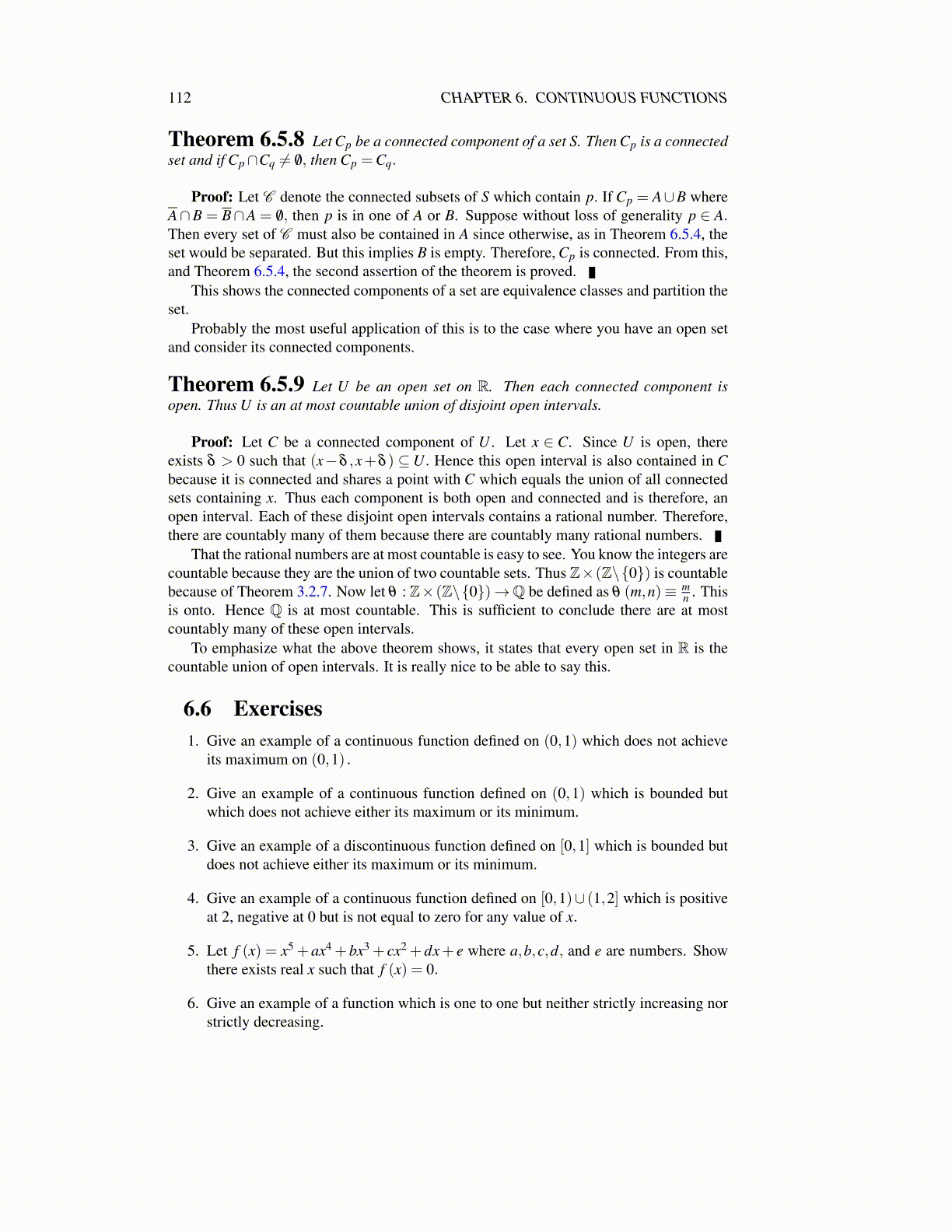
112 CHAPTER 6. CONTINUOUS FUNCTIONS
6.7 Uniform ContinuityThere is a theorem about the integral of a continuous function which requires the notion ofuniform continuity. Uniform continuity is discussed in this section. Consider the functionf (x) = 1
x for x ∈ (0,1) . This is a continuous function because, by Theorem 6.0.8, it iscontinuous at every point of (0,1) . However, for a given ε > 0, the δ needed in the ε,δdefinition of continuity becomes very small as x gets close to 0. The notion of uniformcontinuity involves being able to choose a single δ which works on the whole domain of f .Here is the definition.
Definition 6.7.1 Let f be a function. Then f is uniformly continuous if for everyε > 0, there exists a δ depending only on ε such that if |x− y|< δ then | f (x)− f (y)|< ε.
It is an amazing fact that under certain conditions continuity implies uniform continuity.
Theorem 6.7.2 Let f : K→ Fq be continuous where K is a sequentially compact setin Fp. Then f is uniformly continuous on K.
Proof: If this is not true, there exists ε > 0 such that for every δ > 0 there exists a pairof points, xδ and yδ such that even though ∥xδ − yδ∥ < δ , ∥ f (xδ )− f (yδ )∥ ≥ ε. Takinga succession of values for δ equal to 1,1/2,1/3, · · · , and letting the exceptional pair ofpoints for δ = 1/n be denoted by xn and yn,
∥xn− yn∥<1n,∥ f (xn)− f (yn)∥ ≥ ε.
Now since K is sequentially compact, there exists a subsequence,{
xnk
}such that xnk →
z ∈ K. Now nk ≥ k and so∥∥xnk − ynk
∥∥< 1k . Consequently, ynk → z also. xnk is like a person
walking toward a certain point and ynk is like a dog on a leash which is constantly gettingshorter. Obviously ynk must also move toward the point also. Indeed,∥∥ynk − z
∥∥≤ ∥∥ynk − xnk
∥∥+∥∥xnk − z∥∥≤ 1
k+∥∥xnk − z
∥∥and the right side converges to 0 as k→ ∞.
By continuity of f and Theorem 6.1.1,
0 = ∥ f (z)− f (z)∥= limk→∞
∥∥ f(xnk
)− f
(ynk
)∥∥≥ ε,
an obvious contradiction. Therefore, the theorem must be true.The following corollary follows from this theorem and Theorems 4.8.14, 4.8.13 which
give closed and bounded sets are sequentially compact.
Corollary 6.7.3 Suppose K is any closed and bounded set in Fp. Then if f is continuouson K, it follows that f is uniformly continuous on K.
6.8 Exercises1. A function f : Fp→ Fq is Holder continuous if there exists a constant, K such that
∥ f (x)− f (y)∥ ≤ K ∥x− y∥α
for all x,y ∈ D. Show every Holder continuous function is uniformly continuous.When α = 1, this is called a Lipschitz function or Lipschitz continuous function.